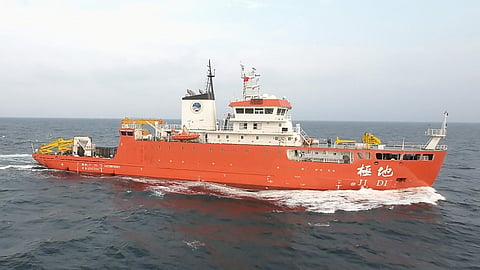VESSEL REVIEW | Jidi – Drone-carrying research icebreaker for Chinese Ministry of Natural Resources
China's Guangzhou Shipyard International has handed over a new large icebreaking research vessel to the country’s Ministry of Natural Resources for operation by its Beihai Bureau. Aptly named Jidi (极地; "Polar"), the vessel will perform environmental monitoring and surveying in ice areas in Bohai Bay and the Yellow Sea, though the summer months will also see it being deployed in polar waters for more comprehensive research activities permitted by the warmer temperatures.
The newbuild, which will embark on its first operational voyage in the second half of this year, has an LOA of 89.95 metres (294.8 feet), a beam of 17.8 metres (58.4 feet), a depth of 8.2 metres (27 feet), a displacement of 5,600 tonnes, and accommodations for 60 crewmembers and scientific personnel. The vessel was designed by the China Shipbuilding Group's 708 Research Institute in compliance with China Classification Society's (CCS) unlimited navigation area requirements to help ensure that it can stay out at sea for a maximum of 80 days. An anti-roll system is also fitted to guarantee stability during extended-duration deployments.
Low-emission, long-endurance operations
The electric propulsion system includes azimuthing thrusters and side thrusters, which are used in conjunction with a DP1 system for improved station keeping. The electric propulsion also satisfies CCS' Underwater Noise 2 and Cabin Noise 1 (55 dB or lower when heard from inside) requirements, thus improving crew comfort and minimising the impact of the vessel’s operations on the surrounding marine environment. The propulsion can also deliver a speed of 15 knots and a range of 14,000 nautical miles.
The bow can break ice up to one metre thick when sailing at two knots while the design of the vessel itself is optimised for temperatures as low as –30 degrees Celsius. The survey equipment meanwhile includes sensors for analysing sea ice as well as those for collecting data on atmospheric and geophysical conditions.
Comprehensive research and unmanned vehicle facilities
Facilities are also available for the transport, deployment and recovery of unmanned aerial vehicles (UAVs), unmanned surface vehicles (USVs), and unmanned underwater vehicles (UUVs). These craft will also be fitted with sensors to augment those on Jidi, particularly in gathering as much data as possible.
The UAV will collect atmospheric and sea ice data while the USVs will operate in areas that Jidi and other traditional crewed vessels cannot access due to their large size. The UUVs will meanwhile focus on deep-sea exploration.
The onboard facilities include laboratory spaces and a data processing centre. The UAVs are deployed via the foredeck while the aft deck features cranes and other equipment for use with USVs, UUVs, and stationary objects such as buoys. The aft deck can also accommodate various payloads such as containers.
A satellite link is used to transmit data from the unmanned vehicles to the larger vessel even before these can be brought back on board the mothership. This guarantees the collection and analysis of data with minimal delay, allowing the unmanned craft to be deployed to where they are urgently needed as soon as their earlier missions are completed.


